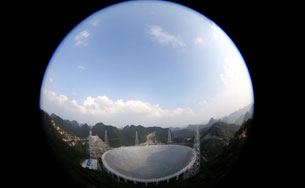
FAST's large hemispheric surface is made up of 4,450 1.3-millimeter-thin reflecting panels, each weighing 427 to 482.5 kilograms. The first panel was installed in August 2015. Patching all the panels together took 11 months.
Sun Caihong, deputy chief engineer for FAST, said the telescope's operators will focus on strong radio sources already known to them. He said scientists are also expecting to make some progress in research by analyzing data they receive in the debugging.
Wang Qiming, chief engineer for FAST, said: "We would like to finish debugging quickly. FAST will be the world leader in 10 to 20 years. We would like to make full use of this period."
FAST already had a good start, scientists said. In a recent test, it received a set of high-quality electromagnetic waves sent from a pulsar about 1,351 light-years away.
It was the best-quality signal that FAST had received since it started its trial observation in mid-September.
Wang said the most challenging part of debugging is adjusting the laser that performs measuring tasks on the reflecting surface. As long as the laser measuring device detects errors in a timely way, scientists can make immediate adjustments.
The telescope is located in an almost-perfect spherical landform, so there was no need to dig a hollow for it. The valley in Guizhou was chosen also for its karst landform, which ensures good drainage, meaning rainwater won't gather and damage the reflecting surface of the telescope.
Philip Diamond, director-general of Square Kilometer Array, a large multiradio telescope project, said: "FAST is the biggest single dish in the world. It will have new technology, and a new receiver system, to be much more efficient. Astronomers and scientists are queuing up all around the word to use it."
Diamond said the SKA, an international project in which China is a member, will be even larger than FAST.
"But ours won't be in the form of one single dish. It will be hundreds and thousands of smaller dishes spread over a large area. They will work together," he said.
"You can think of FAST as a wide-angle lens and the SKA as a zoom lens. FAST will find a lot of objects, and SKA will offer a lot of details on these objects. They will be very complementary."
Anthony Beasley, director of National Radio Astronomy Observatory of the United States, said there are many areas of radio astronomy in which FAST will bring Chinese astronomers to the fore.
Beasley said it likely will be two to three years, while the telescope is brought to its full strength, before they use it.
Construction of the nearly 1.2 billion yuan ($180 million) FAST project started in 2011, 17 years after it was proposed by Chinese astronomers.
Contact the writers at houliqiang@chinadaily.com.cn
Xinhua and AP contributed to this story.
